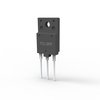Part Details for SSF7N60B by Fairchild Semiconductor Corporation
Results Overview of SSF7N60B by Fairchild Semiconductor Corporation
- Distributor Offerings: (1 listing)
- Number of FFF Equivalents: (0 replacements)
- CAD Models: (Request Part)
- Number of Functional Equivalents: (0 options)
- Part Data Attributes: (Available)
- Reference Designs: (Not Available)
Tip: Data for a part may vary between manufacturers. You can filter for manufacturers on the top of the page next to the part image and part number.
SSF7N60B Information
SSF7N60B by Fairchild Semiconductor Corporation is a Power Field-Effect Transistor.
Power Field-Effect Transistors are under the broader part category of Transistors.
A transistor is a small semiconductor device used to amplify, control, or create electrical signals. When selecting a transistor, factors such as voltage, current rating, gain, and power dissipation must be considered, with common types. Read more about Transistors on our Transistors part category page.
Price & Stock for SSF7N60B
| Part # | Distributor | Description | Stock | Price | Buy | |
|---|---|---|---|---|---|---|
|
|
Rochester Electronics | 5.4A, 600V, 1.2ohm, N-Channel Power MOSFET RoHS: Compliant Status: Obsolete Min Qty: 1 | 282 |
|
$0.4838 / $0.7803 | Buy Now |
Part Details for SSF7N60B
SSF7N60B CAD Models
SSF7N60B Part Data Attributes
|
|
SSF7N60B
Fairchild Semiconductor Corporation
Buy Now
Datasheet
|
Compare Parts:
SSF7N60B
Fairchild Semiconductor Corporation
Power Field-Effect Transistor, 5.4A I(D), 600V, 1.2ohm, 1-Element, N-Channel, Silicon, Metal-oxide Semiconductor FET, TO-3PF, 3 PIN
|
| Rohs Code | Yes | |
| Part Life Cycle Code | Obsolete | |
| Ihs Manufacturer | FAIRCHILD SEMICONDUCTOR CORP | |
| Part Package Code | TO-3PF | |
| Package Description | TO-3PF, 3 PIN | |
| Pin Count | 3 | |
| Reach Compliance Code | unknown | |
| ECCN Code | EAR99 | |
| Avalanche Energy Rating (Eas) | 420 mJ | |
| Case Connection | ISOLATED | |
| Configuration | SINGLE WITH BUILT-IN DIODE | |
| DS Breakdown Voltage-Min | 600 V | |
| Drain Current-Max (ID) | 5.4 A | |
| Drain-source On Resistance-Max | 1.2 Ω | |
| FET Technology | METAL-OXIDE SEMICONDUCTOR | |
| JESD-30 Code | R-PSFM-T3 | |
| JESD-609 Code | e3 | |
| Number of Elements | 1 | |
| Number of Terminals | 3 | |
| Operating Mode | ENHANCEMENT MODE | |
| Operating Temperature-Max | 150 °C | |
| Package Body Material | PLASTIC/EPOXY | |
| Package Shape | RECTANGULAR | |
| Package Style | FLANGE MOUNT | |
| Polarity/Channel Type | N-CHANNEL | |
| Power Dissipation-Max (Abs) | 86 W | |
| Pulsed Drain Current-Max (IDM) | 21.6 A | |
| Qualification Status | Not Qualified | |
| Surface Mount | NO | |
| Terminal Finish | MATTE TIN | |
| Terminal Form | THROUGH-HOLE | |
| Terminal Position | SINGLE | |
| Transistor Application | SWITCHING | |
| Transistor Element Material | SILICON |
SSF7N60B Frequently Asked Questions (FAQ)
-
The maximum operating temperature range for the SSF7N60B is -55°C to 150°C, as specified in the datasheet. However, it's recommended to operate the device within a temperature range of -40°C to 125°C for optimal performance and reliability.
-
To ensure proper biasing, make sure to provide a gate-source voltage (Vgs) within the recommended range of 2V to 5V, and a drain-source voltage (Vds) within the recommended range of 0V to 600V. Additionally, ensure the device is operated within the specified current limits to prevent overheating and damage.
-
The recommended gate resistor value for the SSF7N60B is typically in the range of 1kΩ to 10kΩ, depending on the specific application and switching frequency. A higher gate resistor value can help reduce electromagnetic interference (EMI) and ringing, while a lower value can improve switching speed.
-
Yes, the SSF7N60B is suitable for high-frequency switching applications up to 100 kHz. However, it's essential to consider the device's switching characteristics, such as rise and fall times, and ensure proper layout and decoupling to minimize ringing and EMI.
-
To protect the SSF7N60B from overvoltage and overcurrent conditions, consider using a voltage clamp or transient voltage suppressor (TVS) to limit voltage spikes, and a current sense resistor or fuse to detect and respond to overcurrent conditions. Additionally, ensure the device is operated within the specified maximum ratings and follow proper PCB layout and thermal management practices.
